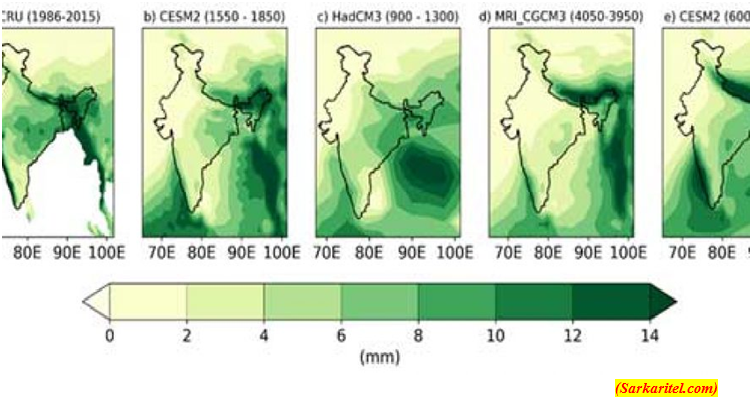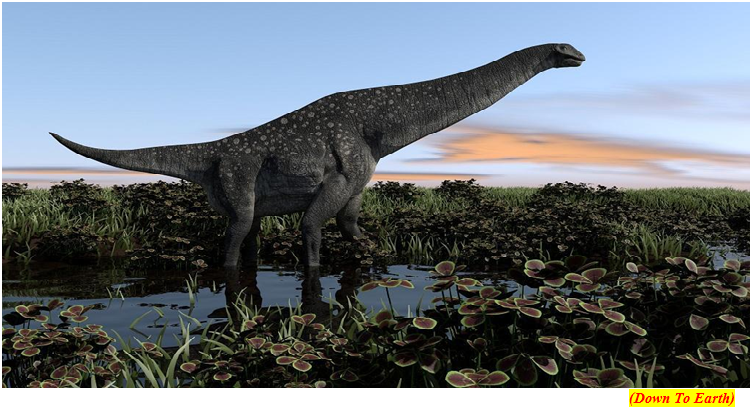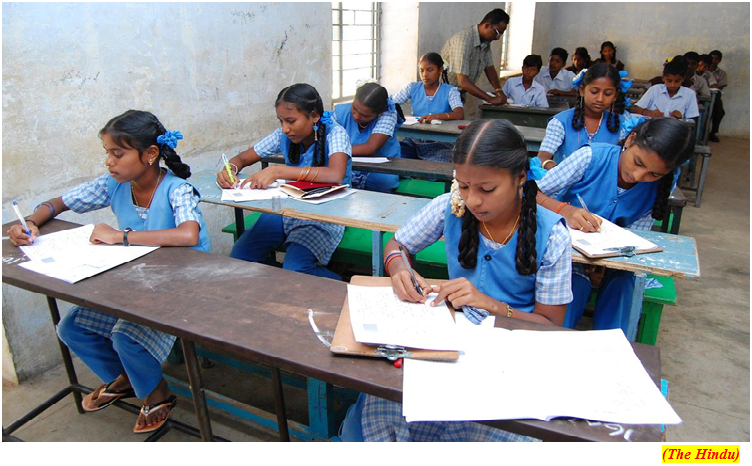Study traces high rainfall in Northern Bay of Bengal than the other parts of India for the last 10000 years (GS Paper 1, Geography)

Why in news?
- Regions surrounding northern Bay of Bengal (BoB) received higher precipitation than the other parts of India for the last 10200 years, says a new study.
- The studyhas traced the dynamics of Indian Summer Monsoon Rainfall (ISMR) over the 10000 years, a period which witnessed the development and fall of numerous ancient civilizations around the world, many of which were associated with climate instability.
- The study can help understand long-term trends of climate change impacts on the ecosystems and may help mitigate future climate extremities.
Why it matters?
- Agriculture in India is heavily dependent on the Indian Summer Monsoon rains (ISMR). The Bengal Basin or the ‘Bengal region’ being located at the trajectory of the Bay of Bengal (BoB) branch of the ISM is very sensitive to changes in the ISM strength.
- Even a minor change in ISM strength may have adverse effects on the agrarian-based socioeconomic conditions of the region. However, no systematic long-term record (beyond the range of instrumental period) for the past ISM variability in the region was available.
Key Highlights:
- BSIP, an autonomous institute of Department of Science and Technology (DST), for the first time, reconstructed the history of the ISM variability from this region by using both biotic and abiotic proxies that predates instrumental records (records taken before 19th Century).
- In the hydro-climatic history of the last 10.2 ka (10,200 years) of the Bengal region, a team of scientists show that a heavy ISMR was witnessed during 10.2 – 5.6 ka by this region and the ISMR decreased since 4.3 ka.
- The ISM again got strengthened between 3.7 and 2.1 ka following which it switched to a drier mode for some time. The ISM regained its strength during 0.2–0.1 ka. Of the weakened phases,weakening around 4.3 ka was the most severe one, and had adverse impact of the ecosystem.
How predictions were made?
- The scientists collected sediment samples from the bed of a dried lake from the northern part of the Bengal Basin and standard techniques were followed for building the age-depth model of sedimentary sequence and measuring different palaeo- climatological parameters.
- They also compared the proxy-based results with a few palaeo-model outputs from the Palaeo Modelling experiments for different time spans to validate the results of this study.
- The numerical models provided insights into the spatio- temporal dimensions of climate change and helped analyse the dynamic relations between different climatic components under specific boundary conditions. Combining these datasets, they investigated the timing, regional coherence and causes of Holocene ISM variability in the Bengal region.
- They explored the drivers influencing the variability of the monsoon in the Indian part of the Bengal Basin and found that while the millennial-scale variations in the ISM rainfall may largely be attributed to changes in solar insolation and dynamics of Inter tropical Convergence Zone, the centennial scale variations may be collectively triggered by phenomena like North Atlantic Oscillation, El Nino Southern Oscillation and Indian Ocean Dipole.
Way Forward:
- Focusing on monsoonal variability in the Indian part of the Bengal Basin, the scientists combined both biotic (phytoliths, NPPs and stable carbon isotopes) and abiotic (environmental magnetic parameters, and grain size data) proxy data to understand the ecosystem response to past hydroclimatic changes.
- They inferred that changes in Lake Ecosystem were strongly influenced by the ISM rainfall.
Rare dinosaur eggs found in Narmada Valley show how ancient reptiles shared traits with today’s birds: Study
(GS Paper 3, Science and Tech)
Why in news?
- A group of Indian researchers found rare cases of fossilised dinosaur eggs, an egg within an egg among 256 newly discovered eggs from the Narmada Valley.

Key Highlights:
- The discovery suggests that Titanosaurs, one of the largest dinosaurs to have roamed the Earth, displayed a notable reproductive trait unique to modern-day birds.
- The unique feature of egg within the egg has not been reported from any other dinosaur or even in other reptiles.
- The egg has two yolks; this feature can be seen in birds, suggesting they share similar reproductive traits.
Details:
- They discovered 92 nesting sites containing 265 fossilised eggs, measuring 15-17 centimetres in diameter during field investigations in the Dhar district of Madhya Pradesh between 2017 and 2020.
- This region falls between the easternmost Lameta exposures at Jabalpur in the upper Narmada Valley (central India) and Balasinor in the west in the lower Narmada Valley (western central India), according to the document.
- Lameta exposure is a sedimentary rock formation known for its dinosaur fossils. The fossil records here are largely concealed by Deccan volcanic flows, which prevents their removal by erosion.
Unique features:
- The eggs belonged to six species, suggesting a higher diversity of these extinct giants in India. Further, Titanosaurs buried their eggs in shallow pits, a behaviour seen in modern-day crocodiles.
- They nested in colonies, a feature found in about 13 per cent of modern-day birds. They also laid eggs in sequential order like avian species.
- Parental care was likely absent as the eggs were laid too close to each other. The spacing did not provide room for adults, suggesting that hatchings were forced to fend for themselves.
Impact of “egg-in-egg feature”:
- The “egg-in-egg feature” did not benefit the dinosaurs. The pore canals get blocked due to the presence of two eggshell layers, one above the other. This could asphyxiate the embryo.
- Among the fossils, they also found unhatched eggs. Infertility, embryo death before hatching and deep burial could have contributed to their death. Environmental factors such as floods could also be involved.
- Fossilised eggs provide clues on reproductive biology, nesting behaviour and parental care.
What’s next?
- They hopes to study fossil bone and teeth specimens from the Lameta Formation of Narmada Valley.
- They also plan to scan the eggs to search for embryo or juvenile fossil specimens.
Flip the page to the chapter on middle schoolchildren
(GS Paper 1, Social Issues)
Context:
- After a gap of four years, the Annual Status of Education Report (ASER) report for 2022 was recently released in New Delhi.
- This nationwide household survey that covers all rural districts in the country generates estimates for schooling and basic learning for every State in India. Data from 2018 and 2022 can be compared with longer run trends over the last decade to see how the COVID-19 years have impacted India.

(The Hindu)
NEP 2020:
- The National Education Policy 2020 gives high priority to the acquisition of foundational literacy and numeracy skills especially for children in early grades.
- “NIPUN Bharat” (where NIPUN is National Initiative for Proficiency in Reading with Understanding and Numeracy) the government’s flagship programme designed to translate policy into practice, is beginning to have traction in many States.
- Given that the policy and implementation focus currently is on early years in primary school, it may be useful to also understand how older children in upper primary grades are faring.
Enrolment ratio:
- In 2018, the all-India rural enrolment figure for the age group 6-14 years was 97.2%. In ASER 2022 data, this is now 98.4%. The rise has been accompanied by a significant shift away from private schools to government schools.
- Several factors may be at play; decrease in family income, permanent closures of low-cost private schools, and the efforts of many State governments to provide services even when schools were closed such as mid-day meal rations, teaching-learning materials shared remotely, worksheet and textbook distribution.
Evaluation of rising enrolment:
- On the ‘plus’ side, rising enrolment means that more students can benefit for longer, sustained periods of time from schooling. Completion of the entire cycle of eight years of schooling for each cohort of 25 million students is no mean achievement in a country of India’s size and diversity.
- On the ‘minus’ side, with more and more students going through the middle school pipeline and attending secondary schools, there is increased competition for post-secondary opportunities. Board examinations continue to perform a gatekeeping function.
- Acute examination stress, grade inflation in school-leaving examinations, difficulties of gaining admission into college, and lack of appropriate jobs for many school leavers are all consequences of high enrolment and completion rates.
ASER measurement mechanism:
- Since its inception, ASER has measured foundational skills in reading and arithmetic. The highest reading task on the ASER tool is reading a text at Grade II level of difficulty.
- In mathematics, the highest level is a numerical three-digit by one-digit division problem, usually expected of children in standard four or so. The assessment is done one on one with each sampled child in the household. The child is marked at the highest level that she/he can comfortably reach. The same tasks are used for all children aged 5 years to 16 years.
- ASER data shows that even in 2018, basic skills of children in upper primary grades left a lot to be desired: less than a third of all children in standard five and less than half of those in standard eight could do division in pre-COVID-19 times.
- These low levels which are worrying declined further between 2018 and 2022, especially in reading. ASER evidence suggests that basic learning levels of middle schoolchildren have remained low and stagnant for over a decade. The “value” add of each year of middle school is small.
Conclusion:
- In the last 10 years, much has changed such as new technologies, new knowledge domains, and new ways of operating. But within our school systems, many children are reaching standard eight without being sufficiently equipped with foundational literacy and numeracy skills, let alone higher-level capabilities.
- Unless children have strong foundational skills, they cannot acquire higher level skills or develop advanced content knowledge.
- ASER data shows that an “overambitious” curriculum and the linear age-grade organisational structure of Indian schools result in a vast majority of children getting “left behind” early in their school career.
- In the absence of in-school mechanisms for “catch up”, children fall further and further behind academically. With this comes low motivation to learn and a lack of self-confidence. At the same time, as children reach higher grades, parental and family aspirations for the child’s future increase.
Way Forward:
- Much of the country’s efforts in school education today are focused on ensuring strong foundations for children in the early years. But it is critical that we remember that middle schoolchildren also urgently need support for learning recovery and “catch up”.




